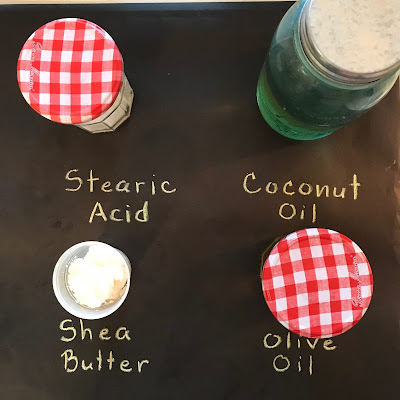Do you want to make your own soap at home? Here's one of the soap recipes I use for all the handcrafted soap that we use around here plus what I make to share with friends and honey customers. The first homemade soaps that I created were just melt and pour with premade soap from a craft store. If you are looking to create some cute gifts that are unique and fun that is the absolute easiest way to go. You can toss science and measuring aside and just get to the fun and creative part.
Here's a post about how easy it is to do and although I still added more stuff to it you can absolutely just melt and pour the soap. Goat's Milk and Honey Soap
But of course, your girl here has to take it one step further and make real legit lye soap like grandma made. And yes I know all soap has lye, in case you are an expert soaper who was about to leave a snarky comment, but everyone else doesn't know that. I like information and baby steps. So...
Let's get started!
But first...
SAFETY. SAFETY. SAFETY.
Lye is an extremely dangerous thing to work with. Especially when it is mixed with water. Always wear eye protection, rubber gloves, long sleeves, pants, and shoes for your protection. Do not make soap in the presence of children or pets!
Now that I've scared you silly, let's have some fun.
Ingredients:
distilled water
lye
coconut oil
olive oil
shea butter
stearic acid
Equipment:
Eye protection
Rubber gloves
Digital scale
stainless steel thermometer
large glass container
large stainless steel pot
non-reactive spoon or spatula
stick blender
mold
oils or scents
color
The Process:
Lye + water + oil/fat = soap
Lye (sodium hydroxide) is a salt. When the lye is combined with the oils/fats a the process that takes place is called saponification. Though lye is caustic in its original form once the saponification process is complete, no lye will be left in the finished product.
Measuring:
Because a chemical reaction is taking place is it important that you carefully measure all the ingredients. It's best not to use kitchen measuring cups or spoons for this but a digital scale.
The measurements I use for this recipe are:
16 oz. coconut oil
2 oz. olive oil
2 oz. shea butter
1 oz. stearic acid
3.4 oz. lye
7.1 oz. distilled water
Making the soap:
Carefully and slowly add the lye to the water (never the water to the lye!!!) and stir. Let cool.
Melt the oils and fats together in a glass container in the microwave. I add the shea butter last because it can get a little grainy if overheated.
Measure the temperature of the lye mixture and the oil mixture until they have cooled to 10 degrees of each other and are both below 130 degrees.
Pour the melted oils/fats into a large stainless steel pot. Carefully (are you wearing your goggles and gloves?) pour the lye mixture into the pot and stir. Next, insert the stick blender and begin blending your soap mixture. Gently, not vigorously. You don't want to introduce air bubbles. Continue blending until you achieve "trace."
Trace is when you can see a trail where you have dragged the blender through or when you drip some soap on the surface and it doesn't immediately disappear. Add colors and scents at this point and give a quick blend then pour it into your mold. If you want to put anything in it that will remain solid now is the time to do that. I like to encrust my soap with herbs or flowers.
Cover with a towel to prevent cracking from it cooling too quickly.
The next day pop it out of the mold and cut if necessary depending on the type of mold you choose. Place in a cool dry place with good air circulation for 3-6 weeks. The process of making soap isn't finished until it has fully cured.
After that enjoy your luxurious homemade soap!
XOXO Y'all!
XOXO Y'all!







No comments:
Post a Comment
Let's put the social back in social media and continue the conversation on Facebook! Check out the Pen and Hive Page.